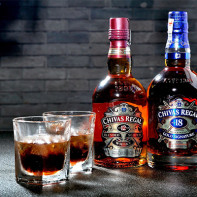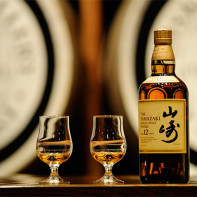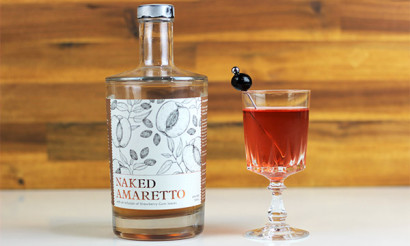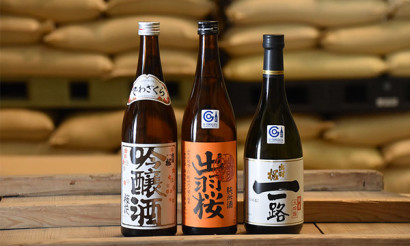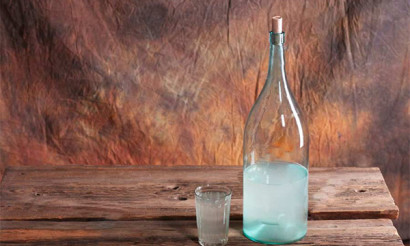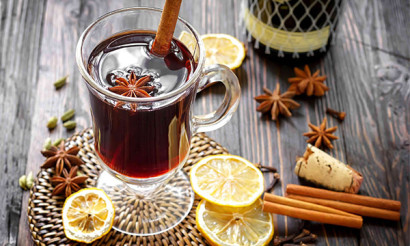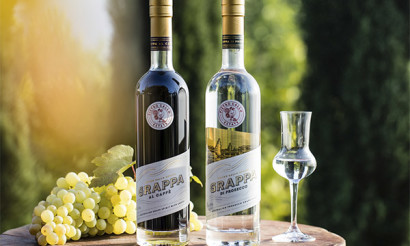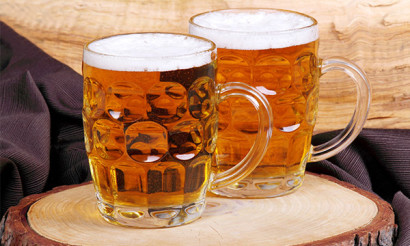How to drink whisky correctly
The process of tasting alcoholic beverages brings enjoyment to the palate. Every kind needs the appropriate environment, dishes, snacks, and whiskey is no exception. For many years Scotland and Ireland have been challenged to call it home and new ways of drinking this golden, strong whisky have been enthusiastically invented all over the world.
- What is whiskey
- History of the drink
- Types
- Famous Brands
- Composition and calories
- Rules of serving whisky
- Temperature
- Choice of tableware
- Etiquette
- How to drink whisky correctly
- What to drink with
- With Whisky Snacks
- How to drink various whiskies
- Jack Daniels
- White Horse
- Red Label
- Jameson
- Can Whiskey Follow Other Drinks
- Whiskey Cocktails: Recipes
- Manhattan
- Whiskey Coke
- Irish Coffee
- Sauer Whiskey
- Health & Welfare
- How to make whiskey at home
- Interesting Facts About Whiskey
What is whiskey?
So called single malt or blended spirits, strength 32-50%, passed the stages of fermentation, distillation, aging in oak barrels. At the same time there is a strict restriction on the naming. Only Scotch whisky made from barley is called Scotch, while bourbon is the drink produced in North America.
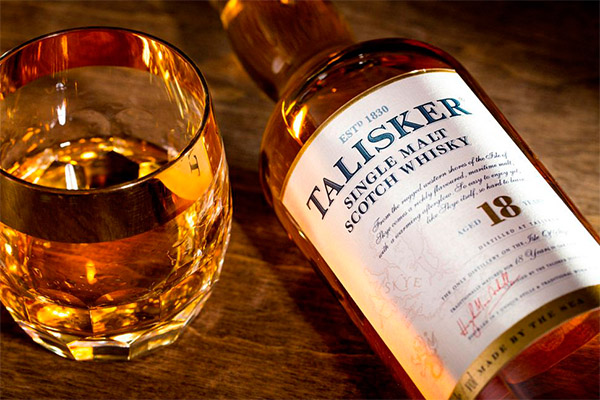
History of the drink
Historians are inclined to believe that the name of the drink comes from the Celtic "uisge beatha" or "living water." In the harsh conditions of the rocky mountains, in the absence of gardens and vineyards, the locals took barley as the basis, obtaining a magnificent in its taste characteristics drink. There are two versions about its origin, with Scotland and Ireland claiming exclusivity of their invention. Both are partly confirmed by facts, but quite controversial.
Scotland
In the annals the first mention of distillation and obtaining the drink is mentioned in 1494. There is a reasonable suspicion that production began much earlier. The method was adopted from missionaries who adopted it after visiting Arabian countries. The original whisky resembled moonshine. It was also tasted immediately after distillation. Some more far-sighted farmers tried barrel aging, but the experimental samples were often drunk before they had a tangible effect. Nevertheless, the idea caught on, and the high-quality varieties are necessarily placed in oak barrels to achieve a rich taste and the famous golden amber hue.
At first, only monks were engaged in production, then ordinary villagers joined in, who appreciated not only the medicinal possibilities of "living water", but also its great exhilarating properties. The state, seeing what source of wealth passed by the treasury, tried to take control of the production in the 16th century by allowing only the nobility and representatives of the nobility. In the next century excise taxes were invented and issued to the eight largest distilleries. But people continued to produce and drink whiskey without any permission from above. It was necessary to introduce an amnesty in the XIX century and to legalize large and small distilleries.
A special formulation crystallized over the centuries gives only Scotland the right to place the label scotch.
Ireland
The inhabitants showed great ingenuity, not only producing and tasting the drink, but also selling it to the British, who were fighting the Scots over territory. In this way they ensured their entry into the international market. The legends say that St Patrick gave the residents the recipe for whisky and at the same time introduced the pagans to the true faith and drove the poisonous snakes from the Emerald Isle.
The first trade patent was granted in 1608; it included an indispensable "royal share" for the trade. But the enterprising Irish never showed the true volume of production, and it was steadily increasing as the demand for strong and high-quality alcohol increased.
Besides these two countries, good whiskey is produced in America and Japan. Their brands are also appreciated by gourmets and are popular.
Types
Classification is made by raw material and method of manufacture, country of production.
Varieties
- Malt is considered traditional, quality and expensive. It is made in two ways. Single malt is made from barley by the same distillery, a mixture of spirits of different ages is allowed. Barrel malt allows the purchase and use of third-party material from other distilleries. Through the blending of the alcohols and the raw material itself, a more varied shade of flavor is obtained.
- Grain in its pure form is almost never used. It goes as the base of other varieties, as it does not have a strong taste and aroma. It is produced from corn, specially treated barley.
- Blended makes up about 90% of the product for export. It is obtained after the blending of malt and grain types.
- Bourbon is specially singled out. It is produced on the basis of corn and aged only in charred oak barrels.
Countries
The taste characteristics of the drinks are well known to connoisseurs. They will never confuse whisky from Scotland and Japan, despite their similarities:
- Scottish has a deep flavor and gradually unfolding aromatic trail with a flavor of smoke.
- Irish has a persistent aroma and rich color.
- American is bitter and very stable in structure.
- Canadian is matured for at least 3 years, which gives the taste depth and multilayeredness.
- Japanese lacks the flavor of peat, and that is how it is distinguished from Scottish.
Famous Brands
The gradation between whiskey and bourbon is very fine. For example, the degree to which a cask is fired or the length of time it has been aged can affect the margin. Nevertheless, connoisseurs simply call their favorite brands and are ready to find a huge number of arguments to confirm their choice. On the world market they are well known:
- Jack Daniels produced in America.
- Chivas Regal, Scotland, in a line of 6 varieties.
- Johnnie Walker consists of a classic line, a collector's series, a high-end segment and a limited edition collection.
- Ballantine's was produced by the Scots, eventually the line was bought by the French, there are 12 kinds in the assortment, recipes have not changed since the foundation of the company.
- The Macallan offers 7 kinds, it is listed in the Guinness Book of World Records for selling a bottle of whisky worth 250 thousand pounds.
- Hankey Bannister is famous for its quality single malt whisky, the company was founded in 1757, the recipe is carefully guarded and is recognized by a soft balanced blend of spirits from the distilleries of the firm, no third-party raw materials are used.
- White Horse is named after the tavern owned by the distillery owner, the blend is created from 40 varieties of malt and grain spirits.
- The Famous Grouse is known for its amazing creamy taste after 10 years of aging.
- Grant's has won numerous awards in the whiskey segment with at least 12 years of aging.
- Black and White combines a delicate honey flavor with a relatively low price, and the distillery itself is recognized as the highest in Scotland by location.
- Jameson is made by the largest distillery in Ireland using a 200-year-old recipe.
- Black Velvet is made in Canada and really has a velvet flavor.
- Crown Royal began to be produced in the middle of XX century and immediately gained huge success, besides the rich taste, the magnificent design of the bottle played a role.
There are 10 leading Japanese varieties, but they are exported to Asian countries and rarely make it to the Russian shelves.
Composition and calories
As a base comes one of the grains:
- rye;
- barley;
- corn.
Buckwheat is used much less frequently, while in Japan rice, corn and millet are mixed. The production technology is practically the same. The most intense flavor with high quality comes from barley. It is these types that go into the category of collectible and elite.
The caloric value varies in the range of 250 kcal. The exact figure depends on the raw material.
Rules of serving whiskey
To get the full pleasure and enjoy the ensemble of flavor and aroma of whiskey, it is necessary to observe certain temperature conditions, choose the appropriate dishes and create the appropriate entourage.
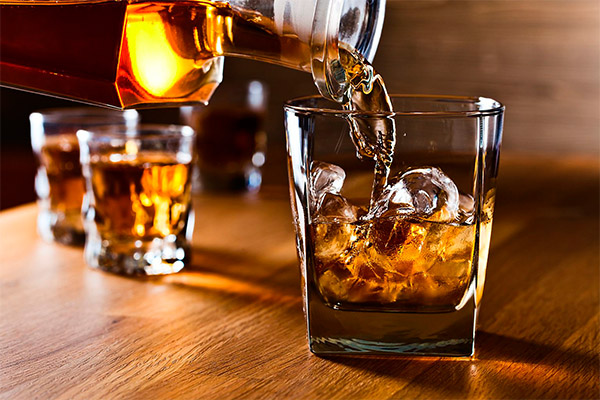
Whiskey is considered an aristocratic drink and should not be served with food. It may be served as an aperitif or digestif, but always apart from the meal. Considered a man's drink, whiskey requires restraint. No matter how feminists were making noises about equality, no matter how indignant the division of the sexes, but florets and lace napkins are superfluous. Leather, wood and restrained lighting look much more organic in the interior, where unhurried enjoyment of whiskey is planned.
The drink is strong, and its time comes in the afternoon or evening. Its effect, soothing, philosophical and unhurriedly friendly, also disposes to this.
Temperature
The permissible backlash is very small, from 18 to 20 degrees. This is explained by the peculiarities of the composition. A warmer liquid will acquire a pungent smell of sivushnyh oils. Deeper cooling will lead to the fact that the flavor and aroma will remain undiscovered.
Choice of tableware
There are no strict rules; advice from connoisseurs is diametrically opposed. Some of them say that only low, heavy cups with thick bottoms are appropriate. Others say that flavor concentrates well in a wine glass. Rather, it is necessary to follow the dictates of the soul and choose something in the cupboard that is comfortable to hold in your hand. When choosing, it is worth considering that the optimal dosage of 1 serving is no more than 30-50 grams.
Peculiarities of serving
A bottle of noble drink is never placed on the dinner table. For this purpose, a small table, perhaps a coffee table, near a comfortable sofa or easy chairs is set up separately. Whiskey is meant for socializing, not for satisfying hunger.
Observance of etiquette
The norms of behavior in the company of noble ladies and gentlemen have not been canceled, and if you want to comply with them, you should consider that:
- In men's company, any participant of the conversation can fill glasses.
- At noisy parties the drink is not served, it requires silence and relaxation.
- If there are ladies in the company, only the host of the house monitors the completeness of the poured glass.
- Light varieties are used as aperitifs, dark ones are offered after the meal.
Important: A cocktail straw and whiskey are incompatible, even as a cocktail.
How to drink whiskey correctly
The strength of the drink is from 32 to 50 degrees. A single shot goes well with a cigar, but a longer conversation will be impossible without a decent snack, even if the celebratory meal recently ended.
What to drink with.
Connoisseurs do not like to mix their drinks, they say better a drop of whiskey than a glass of whiskey watered down. They are right in their own way, limiting themselves to one afternoon or evening drink, sitting in a comfortable armchair with a plaid on the lap and looking at a burning fireplace. But it is possible to combine drinks. If done competently, the flavor will not be lost, but will gain new nuances. Most often allowed:
- Coke;
- juice;
- coffee.
It is worth taking note: a small glass of mineral water without gas will refresh the palate when tasting several varieties.
What to snack on
Preferences vary by country, but the basics remain the same.
- Lighter varieties. They are the lightest, the taste is easily overpowered by a rich range. That is why a variety of seafood is recommended, including red fish smoked or steamed, shrimp, mussels, scallops, grilled sea cocktails with delicate sauces.
- Scotch. Veal tongue, game, and olives must be on the table. Hard cheeses, melon, and smoked fish are good additions. No spicy sauces, plenty of spices, or citrus fruits are allowed.
- Bourbon. Brighten up the taste with a juicy steak and all kinds of meat slices. Fruits, cakes, and bitter chocolate are the second acceptable variant. The aristocracy of the company will emphasize an expensive cigar and a quiet conversation.
- Japanese whiskey. Cheese and Japanese products are allowed on the table. Sushi, tofu and fish dishes will look good.
How to drink a variety of whiskies
The answer to this question is sure to be a request to clarify what kind of whiskey is meant. It is only logical as each brand has its own flavors and each is loved by whiskey lovers.
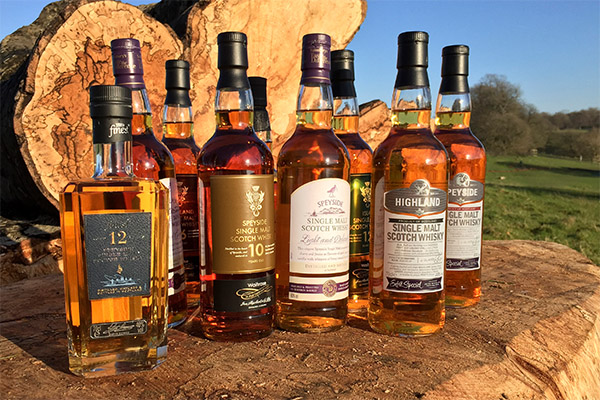
Jack Daniel's
Connoisseurs are inclined to believe that it is not worth spoiling the taste of the drink with additives and snacks. Ice cubes or special chilled stones are used to maintain the temperature and reveal the flavor. In cocktails preference is given to classic recipes, such as "Manhattan", the composition uses ordinary varieties.
White Horse.
Chilled water is a must on the table. The special combination of the flavor of smoke and peat in the drink sometimes needs to be neutralized after a few sips. There are no special subtleties in the consumption of this brand, elite varieties are drunk in pure form, others allow dilution with apple juice or soda.
A little trick: The first sip should be held slightly in the mouth and feel the flavor unfolding process.
Red Label.
It's also commonly drunk undiluted, enjoying the unique combination of peat smoke and a base matured in special local spring water. It's full of minerals, giving it an easily recognizable flavor. In cocktails, they use varieties with minimal maturation, combining them with cola, coffee or juice.
Jemeson
In Irish pubs, it is customary to serve a pitcher of crystal clear, well chilled water along with whiskey. A cheese plate and smoked fish are served as an appetizer. This ends the culinary delights as the thoughtful enjoyment of the drink begins. Juices with neutral flavors are appropriate for cocktails.
Can I drink whiskey after other drinks?
Yes, but why? The strength allows you to "crank up the degree" without going out in the morning in a brutal hangover. But it is worth remembering that whiskey is an aristocratic egoist and does not tolerate rivals.
- Beer and whiskey are made from barley, the raw materials are similar, the combination is not bad if you do not fall into fanaticism and do not measure the pleasure by liters.
- The combination with wine is not the best option. Both drinks have an individual taste bouquet, so there is no need to mix them. The only fact that would excuse such a mix would be to switch to another company. But then it's worth starting with wine.
- Only extreme drinkers drink whiskey after vodka. Despite almost the same level of strength, the raw materials are different, which is sure to affect the morning feeling. And most importantly, no champagne before or after.
Cocktails with whiskey: recipes
This type of alcohol does not tolerate rivals, its character is harsh and straightforward. Cocktail recipes do not contain complex ingredients and are easy to prepare.

Manhattan
The recipe is said to have been created at the end of the nineteenth century, quickly became a classic and is now a must-have menu item in most bars. To make it, orange and apricot juices, whiskey, and some ice are taken in equal proportions. The mixture is shaken in a shaker, poured into a martin and decorated with a cherry.
Whiskey Cola
Simple as can be and just as popular. The two ingredients are taken in equal proportions, mixed, and served immediately before the soda loses its famous bubbles.
Irish Coffee.
More difficult to prepare, but gives an unforgettable taste experience from the combination of cream, coffee, sugar syrup, water and quality aged whiskey. The coffee is brewed first, then the rest of the ingredients are added to the finished mixture and garnished with whipped cream.
Sauer Whiskey
In terms of popularity it is steadily keeping its place in the top five. It is made of whiskey, lemon juice and sugar syrup. They balance the taste and the whiskey enhances the resulting bouquet of fresh citrus notes and the deep aroma of elite alcohol. After mixing in a shaker, pour the mixture into a tall glass, add a few drops of red wine and 2 ice cubes. The glass is decorated with a lemon or orange spiral.
Health and harm of whisky
In most cases, strong alcohol was first a medicine and prescribed in drops. It was excellent for relieving stomach upsets, healing intestinal infections, and having a relaxing effect on the body and soul. The monks were the first to test its medicinal properties. In monastic hospitals whiskey was used for disinfecting, as a mild sleeping aid, anti-inflammatory and antibacterial. A small therapeutic dose stimulates the heart muscle, blood circulation, speed of perception.
At the diagnosis of cancerous tumors small portions of whiskey block further cellular degeneration, giving the necessary time for a course of treatment. 30 ml a day will remove phlegm from the lungs, eliminate constipation, and serve as a shield against the development of Alzheimer's disease.
It is not the product itself that causes harm, but its excessive amount. It is also not recommended to drink alcohol in children, pregnant women, people with unstable psyche.
How to make whiskey at home
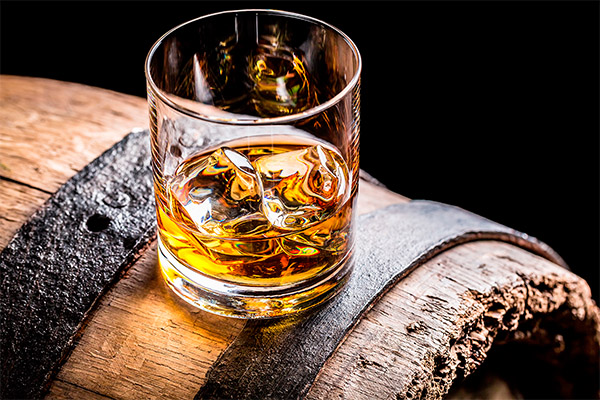
There are fans of the drink not only in Scotland and Ireland. Sometimes you want to make your own favorite product, and it is quite possible. To make it you will need:
- 8 kg of barley malt;
- 32 liters of water;
- 300 grams of live pressed yeast.
Important: yeast is diluted only with warm, standing water. In a cold fermentation will not begin, in a hot culture will boil.
The taste is influenced not only by the quality of the malt, but also by the water. It is best to take spring or filtered water. Boiled is useless.
The malt is crushed into pieces of medium size, it is easier for beginners to buy raw materials of the right size. A bowl of water is heated to 70 degrees, malt is poured there with continuous stirring clockwise. The mixture should be homogeneous, without lumps. It is tightly covered with a lid, bring to 65 degrees and kept at a constant temperature for 1.5 hours. The end of the process is determined by the stratification of the mixture, where the liquid will lighten and the suspension will settle to the bottom.
The container is quickly cooled to 25 degrees, diluted yeast is poured in, a water trap is installed and transferred to a dark cool room. The fermentation time lasts 15 days, the mixture is stirred daily with a hand or stick. Then double distillation is carried out, in which the yield of the finished product will be 4-5 liters with a strength within 45 degrees.
The most important part is aging in an oak barrel or container with wooden stakes. It takes at least 6 months. Only in this case, the drink will acquire the necessary palette of taste and unforgettable aroma.
Facts of interest about scotch
- The drink has the smallest range of recommended temperature for serving and is only 3 degrees between +18 and +20.
- Once corked it can be stored for a century without loss of quality.
- Churchill was a great connoisseur of whiskey and even during the economic downturn he did not allow barley cultivation to decrease.
- The dispute between Ireland and Scotland over which of them discovered the recipe for whiskey is still going on.
- Whiskey translates as "living water", the name given to it by the monks who made it.
It is believed that some 5,000 varieties of the drink have been developed and produced, if you count the most minor changes in the recipe. Connoisseurs say that whiskey cannot stand mixing with other kinds of alcohol and there is definitely some truth in it. And most importantly, this drink does not tolerate fuss and consumption on the run. It requires an appropriate environment and only then reveals the depth of taste and the magic of flavor.
«Important: All information on this site is provided solely for introductory for informational purposes only. Before applying any recommendations, consult a health care professional. specialist. Neither the editors nor the authors shall be held liable for any possible harm caused by materials."



